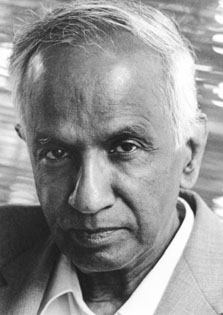| Subrahmanyan Chandrasekhar  Born: 19-Oct-1910 Born: 19-Oct-1910
Birthplace: Lahore, Pakistan
Died: 21-Aug-1995
Location of death: Chicago, IL
Cause of death: Heart Failure
Gender: Male
Religion: Atheist
Race or Ethnicity: Asian/Indian
Sexual orientation: Straight
Occupation: Astronomer, Physicist Nationality: United States
Executive summary: Evolutionary stages of stars American astrophysicist Subrahmanyan "Chandra" Chandrasekhar is responsible for much of the modern baseline understanding of stellar evolution — the origins, structure, dynamics, and deaths of stars. In his 1939 book Introduction to the Study of Stellar Structure, he calculated that a star with a remaining mass greater than 1.4 times that of the Sun (now called the Chandrasekhar limit) will, following its red giant phase, collapse and become a neutron star during a supernova explosion. He also showed that a star will collapse once it has exhausted its nuclear fuel, a process that will end in most stars because of the outward pressure exerted by a degenerate gas; but that stars more enormous than about three solar masses can collapse into themselves, becoming black holes.
Acceptance of Chandrasekhar's work was delayed for decades by the opposition and ridicule of Arthur Eddington, who was among the most respected astronomers of the era, and described Chandrasekhar's theory that stars could evolve into anything but white dwarfs as "almost a reductio ad absurdum of the relativistic degeneracy formula". Unwilling to feud with Eddington, he let his exceptionally lucid work speak for itself and moved on to study several other areas of astrophysics, including the theory of radiative transfer, the quantum theory of the negative ion of hydrogen, and hydrodynamic and hydromagnetic stability.
He won the Nobel Prize for Physics in 1983, almost four decades after Eddington's death. Chandrasekhar's students included Carl Sagan and Donald E. Osterbrock, and his paternal uncle, Chandrasekhara Venkata Raman, won the Nobel Prize for Physics in 1930. Father: Chandrasekhara Subrahmanya Ayyar (civil servant)
Mother: Sita Balakrishnan (translator)
Wife: Lalitha Doraiswamy (b. 1911, m. 1936)
High School: Hindu Higher Secondary School, Triplicane, Chennai, India (1925)
University: BS Physics, Presidency College, Madras (1928)
University: MS Physics, Presidency College, Madras (1930)
University: PhD Physics, Trinity College, Cambridge University (1933)
Scholar: Institute of Theoretical Physics, University of Copenhagen (1932-33)
Fellow: Trinity College, Cambridge University (1933-37)
Professor: Physics, University of Chicago (1937-43)
Scholar: Yerkes Observatory, University of Chicago (1937-71)
Professor: Physics, University of Chicago (1943-52)
Professor: Hull Professor of Theoretical Astrophysics, University of Chicago (1952-86)
ACS Roger Adams Medal 1947
Bruce Medal 1952
Royal Astronomical Society Gold Medal 1953
Rumford Prize 1957
INSA Srinivasa Ramanujan Medal 1962
Royal Medal 1962
National Medal of Science 1966
Padma Award 1968 (Vibhushan)
Henry Draper Medal 1971
PPS Smoluchowski Medal 1973
Dannie Heineman Prize for Mathematical Physics 1974
Nobel Prize for Physics 1983 (with William A. Fowler)
Copley Medal 1984
IPA R. D. Birla Memorial Award 1984
Tomalla Prize 1984
INSA Vainu Bappu Memorial Gold Medal 1985
Gordon J. Laing Award 1989
Astrophysical Journal Managing Editor, 1952-71
American Astronomical Society
International Academy of Science
National Academy of Sciences 1955
Royal Astronomical Society Foreign Member, 1932
Royal Society Foreign Member, 1944
Naturalized US Citizen 1953
Heart Bypass Operation 1977
Indian Ancestry
Pakistani Ancestry
Heart Attack 21-Aug-1995 (fatal)
Asteroid Namesake 1958 Chandra
Author of books:
Introduction to the Study of Stellar Structure (1939)
Principles of Stellar Dynamics (1942)
Radiative Transfer (1950)
Plasma Physics (1960)
Hydrodynamic and Hydromagnetic Stability (1961)
Ellipsoidal Figures of Equilibrium (1969)
The Mathematical Theory of Black Holes (1983)
Truth and Beauty: Aesthetics and Motivations in Science (1987)
Newton's Principia for the Common Reader (1995)
Requires Flash 7+ and Javascript.
Do you know something we don't?
Submit a correction or make a comment about this profile
Copyright ©2019 Soylent Communications
|